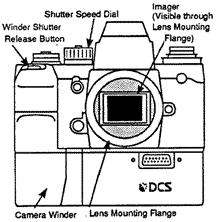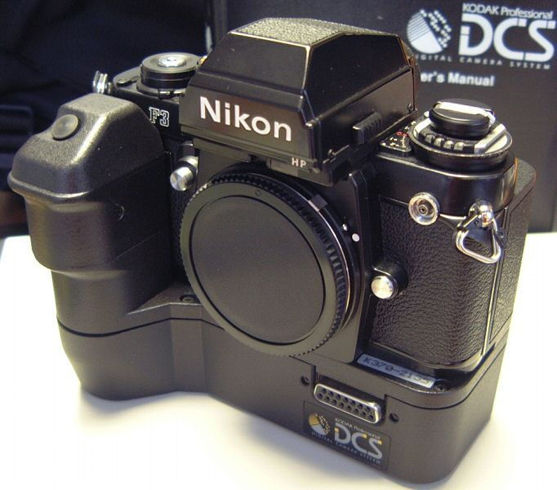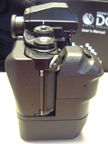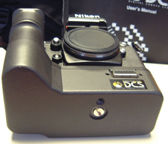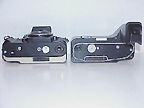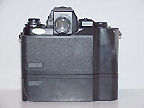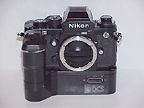Please note: An image must be in DRAM before it can be shown on the image display. There are several ways in which you can place images into DRAM. When you make pictures, each image is first placed into DRAM, and then moved to the hard disk, When DRAM contains no images, as it does when you first turn on the DSU, it is possible to shoot six pictures continuously (with eight MB of DRAM) at the rate of 2.5 images per second (one image every OA seconds). This rate will be slower when the video display is on. If you continue to depress the shutter release button, new pictures are made at a rate of 03 images per second (one image every two seconds) as images already in DRAM are moved to disk to make room for the new imago. (The optional 32-megabyte DRAM allows for a burst of 24 images.) You can also move images into DRAM from the hard disk by pressing HOME, <, >, and Find Tags while the image display is on. The display also equipped with zoom key to view images as well as 3-settings on WHITE BALANCE (Daylight/Tungsten and FLUOR light source). Also note: Image files stored on the DSU are only 1/3 in file size as compared to files imported into the computer via Kodak's software. Battery and Battery Charger You can operate the digital storage unit (DSU) from a standard rechargeable 12-volt, 2.3 ampere-hour camcorder battery. (As an alternate from an external AC adapter). Kodak recommended other 3rd parties alternatives such as Panasonic LC 2012 (2 Ah); Panasonic LC 2312 (2.3 Ah) and chargers such as: Chinon CV AC32; Mips V8809313KOI or Aztec AZ 1223. Motor Drive: Recocks the shutter through the camera motor drive coupler. The motor drive provides for a maximum burst rate of 2.5 images/second. Note: The Nikon F3 camera that the shutter be recocked after each photograph. Since the digital'camera system uses an unmodified Nikon F3 camera, the camera system must recock the shutter em though you are not using film. Shutter release button: Trips the shutter; used instead of the shutter release button on the Nikon F3 camera. Interconnect cable Connects the camera winder to the DSU. Other features: Video out port for immediate viewing via TV-screen, SCSI interface connectivity.
 |
Credit: Image of this rare early version of the Kodak Digitalsetup courtesy of Ebay ID: "'ds-spc' (StephensPhotoCentre)"who specialises in Leica, Nikon and all collectable cameras ( Ship Worldwide). The Company also operates a popular Ebay Store. All images appeared herein are Copyright © 2005. All rights reserved. Please respect the visual property of the contributing photographer.
MORE Information on Nikon F3 and all its variants ...
|
1992 The company announced a joint R&D project with Canon, Fuji, Minolta and Nikon to develop an Advanced Photographic System ("APS").
1992/3. Kodak Professional DCS-200 Digital Still SLR camera. The year also saw Kodak introduced another early consumer digital products, the 1.54 million DCS 200 Digital Camera back which also uses combination of Kodak software/Nikon optic, the camera has a built-in hard drive for image recording and it was an entirely different package from the early DCS-100 module as basically the camera used as its backbone was a all electronic Nikon AF-SLR F801 (N8808s in North America).
As the camera does not required the bulky Storage Unit that came with the earlier DCS-100. So, comparatively, it is more compact and highly portable as it is without cable but still weighs approx. 1,7 kg The 14 x 9.3mm imager delivers 1524 x 1012 pixels image capacity.. The size of the picture in viewfinder of DCS 200 is near of the size of 24 x 36 and to obtain the equivalent focal length in 24 x 36, it is necessary to divide the focal by 2.6X.
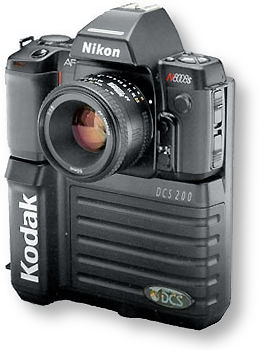 |
DCS 200 Camera Models: Five camera models are available: DCS 200ci (color camera, 50-image internal hard disk), DCS 200c (color camera, single-image storage), DCS 200mi (monochrome camera, 50-image internal hard disk), DCS 200mi (monochrome camera,, single-image storage) and DCS -200IR (infrared monochrome camera, 50-image internal hard disk). The built-in 80 megabyte hard disk can store fifty pictures; each picture needs 4,5 Meg. To visualize pictures taken, it is necessary to unload the content of the hard disk on a microcomputer via the integrated SCSI interface. DCS 200 does not comprise integrated LCD monitor screen. It is possible to take a picture every 2,5 seconds. Batteries allow to take a hundred of pictures.
NOTE: -See Instruction Manuals for respective Models at the bottom of this page.
|
Although the DCS 200 Camera operates with an unmodified Nikon N8808s camera, there are differences between normal operation of the Nikon N8808s camera and its operation as part of the DCS 200 Camera. Firstly, he KODAK camera back comes attached to the Nikon camera body, with the DCS-200, you use the KODAK camera back incorporating a Kodak imager instead of the Nikon N8808s camera back for film. The DCS 200 Camera operates correctly only in single-frame (S) film-advance mode. You must use only the prescribed ISO settings. Select an ISO setting of 50, 100, 200, or 400 for color camera backs, or 100, 200, 400, or 880 for monochrome cameras. Multiple-exposure mode does not work. The film installation mark, film advance and rewind mark, and frame counter do not appear in the Nikon N8808s camera liquid crystal display (LCD). (A frame counter appears in the LCD in the KODAK camera back.)
The pictures you take are stored on the internal hard disk in the DCS 200 Camera, OR on an optional external hard disk, or in single-image dynamic random access memory. Please also note that: DCS 200 Camera operates correctly only in single-frame film-advance mode (NOTES. If either the CL or CH film modes are selected, later when you take pictures, the camera will continuously take pictures although only the first shot will I be recorded).NEXT; the camera batteries do not provide any power to the camera back, and the camera back batteries do not provide any power to the camera. If you use the AC battery charger/adapter it provides power to and charges only the rechargeable batteries in the camera back, it has no effect on the batteries in the Nikon camera. Further, In selecting an exposure setting begin with lower exposure index settings; reserve the use of higher speeds only for situations requiring their use. Higher speeds may result In lower-quality images than lower speeds. Later, if you are unable to take pictures, you may see "ISO" blinking on the KODAK camera back LCD. This indicates that the camera body is not set to one of the four prescribed ISO settings. The camera may not shoot in this condition. Reset the ISO. When the light level is not favorable, (Optional) when in doubt, use a flash both indoors and outdoors. flash performs as you would expect it to with the regular camera. Set an SB-24. 25, 26 etc. Nikon speedlights to shoot in TTL, Normal mode. Lastly, Center-weighted metering and Spot metering can be used. Matrix metering is NOT supported. You can take pictures with the camera while it is connected to the computer (for example in a studio setting), however, you cannot connect the camera to your computer while an optional external hard disk is connected. The DELETE button on the camera back is disabled while the camera is connected to a computer. Instead use the DeLETE button on the image window of the software driver to delete selected images.
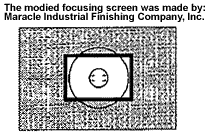 |
 |
The focusing screen shipped in the camera has been modified with a shaded border to reduce your view of the scene to match the size of the picture that will be recorded on the imager (screen can be purchased if damaged, see below). Your picture is stored initially in the dynamic random access memory (DRAM). The hard disk must then spin-up before the image can be moved from DRAM to the hard disk (Read below).
|
 |
Please NOTE: The segmented focusing screen causes the field of view equal to use a lense with 2.6 times the focal length of a working lense in 135 format. There is no WHITE BALANCE control on the camera, instead, it is available at the software section when images have been transferred to a computer. The DAY, TUNG, TungBG40, FLUOR, or FLASH choices correspond to daylight, tungsten, tungsten using a Schott BG-40 1 mm filter
|
There is no RAW files output with the DCS-200 but Kodak has an equivalent software where the original image has a significant smaller file size when stored inside the hard disk and will be expanded when imported to the computer (a standard 1.5MB file will be "expanded" into 4.5MB when imported). The driver supplied by Kodak for use with Adobe Photoshop software provides a variety of features that allow you to work with images on the DCS 200 Camera (with or without an internal hard disk), on an optional external hard disk and on the Macintosh computer hard disk. The driver allows you to: Acquire single images from the camera or an external hard disk Into Adobe Photoshop and then edit & save them Into a variety of popular file formats. Note*: Image management of the DC-200 - creates finished files as either FLASHPIX or JPEG files. Interfaces: Windows 16/32 bit DLL and TWAIN32; Interfaces: Macintosh Static Libraries for both PPC and 68K , Shared Library for PPC, and Plug-in Note**: The DC200 Camera has been discontinued on March 1, 1999, It has been replaced in the DC camera family by the DC200 Plus
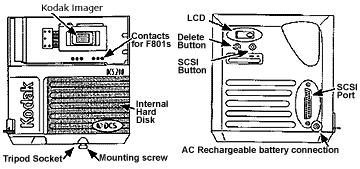 |
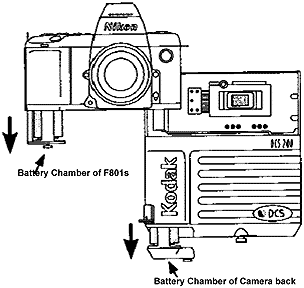 |
|
Camera Back - The DCS 200 Camera can operate from batteries alone, making the system portable, and flexible. The KODAK camera back operates from six M-type rechargeable nickel cadmium batteries. The Nikon N8808s camera operates from four separate AA-type alkaline batteries (or from four M-type NiCad batteries whose '+' terminals do not exceed 6 mm in diameter). The KODAK camera back incorporates a KODAK charge coupled device (CCD) imager available in a color and a monochrome model. When you take a picture, the imager records data on a 1524 x 101 2-pixel matrix, resulting in images composed of 1.5 megapixels of data. Four exposure indexes equivalent to film "eds, of ISO 50, 100, 200 and 400 in color or ISO 100, 200,, 400.. and 880 in black and white. A two megabyte (MB) single-image dynamic random access memory (DRAM) that holds the current image. You can also use an 80 megabyte (MB) internal hard disk that holds 50 images or an optional third-party external hard disk is also available in several different storage capacities. A liquid crystal display (LCD) that shows status and control information. A SCSI port to connect the DCS 200 Camera to your computer for moving images from the camera to your computer. Two controls - one sets the camera back SCSI ID, the other deletes the last image from the hard disk. Software drivers to move images from the camera back to your computer.
 |
DCS 200 Camera models without a hard disk are intended for use when connected to a computer and as each image you take is automatically available for uploading to the computer. a single image which is saved in dynamic random access memory (DRAM). If you take additional pictures, each replaces the previous image in -DRAM; each previous image is lost. |
Using the DCS 200 Camera with an External Hard Disk IMPORTANT. There are SCSI settings on the KODAK camera back and on the external hard disk- however, they do not need to match when the external hard disk is connected to the camera. They are used when connecting to a Macintosh computer or a PC. Once attached to the DCS 200 Camera, the hard disk no longer functions as a general-purpose hard disk, you can only access image data with the supplied software drivers. The oval at the right of the LCD indicates the amount of the hard disk filled with images. As more pictures are taken, subsequent sectors of this graphic appear. The camera will not allow you to take pictures during part of the time that the hard disk is active (writing a captured image). The LCD has a DEL button for deletion of any specified images at will. Please note: No images will be saved to an internal hard disk if an external hard disk is attached. Further, no images will be deleted from the internal disk while an external hard disk is attached. You must remove the external hard disk before you can delete images from the internal hard disk. Multiple external hard disks can be used - one at a time, You can remove one external hard disk from the camera and replace it with another. Do not attach more than one external hard disk to the DCS 200 Camera at the same time; if you do, you may have unpredictable results. You can connect detached external hard disks to a computer and move images from external hard disks to your computer hard disk.
Optional Camera Equipment: KODAK Color Filter Wheel Accessory; CAT No. 130 2447. (For use only with monochrome camera backs with internal hard disks and only with Macintosh computers.) This accessory consists of a motor-driven red, green, and blue filter wheel with support electronics that enables the DCS 200mi monochrome camera model to produce high-quality color images. Sequential red, green, and blue exposures are combined to produce a full 24-bit color image. This accessory cannot be used simultaneously with an external hard disk. We recommend the use of a QB2 (see next paragraph) when using this accessory. External Battery Adapter This accessory is a replacement for the nickel cadmium battery clip in the KODAK camera back. This accessory allows the system to be used with the Quantum Battery 2 (QB2). The QB2 is a rechargeable, external power pack that extends operating time for the DCS-200 Camera. The Q82 should not be used to provide power to an electronic flash, because a low battery condition may occur when the flash is discharged. Schott 1mm BG-40 filter by Schott Glass Technologies Inc. Improves color fidelity under tungsten lighting. These filters must be cut for screw mount holders (by Tiffen), can cut and mount these filters in any lens mount you specify.
Accessories: Focusing screens. Custom focusing screens for the Nikon N8808s camera can be produced by Maracle Industrial Finishing Company, Inc., 39 Commercial Street, Webster, NY 14580,. telephone 716-872-5100, fax 716-872-0285. Pelican Pro Case 1550. A hard shipping case for the DCS- 200 Camera. Available from Bristol Case Company, 34 Elton Street, Rochester, NY 14607,,1-880-343-3408. Electronic Flash and accessories; Extra lenses for the Nikon N8808s camera. Close-up accessories. Nikon remote control accessories; Finder accessories. Batteries: Kodak recommended only nickel cadmium (NiCad) batteries should be used with the KODAK camera back. In an emergency you can use six matching non-rechargeable alkaline batteries, although their life will be shorter (30-40 images) as compared to a fully charged NiCad batteries which can deliver approx. 100-200 images). Please note that: Do not use the AC battery charger adapter while alkaline batteries are in the KODAK camera back. Do not use cables other than those supplied with the DCS 200 Camera which includes the SCSI cables, except that the Nikon remote release cord.
| Previous | NEXT | 1/8 Kodak / Nikon DCS-410 & 420 Dgital Still SLR camera
 for Kodak DCS-System 100 in PDF format Part ONE (4.2 MB) | Part TWO (7.0 MB)
for Kodak DCS-System 100 in PDF format Part ONE (4.2 MB) | Part TWO (7.0 MB)
 for Kodak DCS-System 200 in PDF format Part ONE (5.8 MB) | Part TWO (5.0 MB) | Part THREE (5.8 MB)
for Kodak DCS-System 200 in PDF format Part ONE (5.8 MB) | Part TWO (5.0 MB) | Part THREE (5.8 MB)
DCS-100 | DCS-200 | DCS-410 | DCS-420 | DCS-1, 3, 5 Series | DCS-300 Series | DCS-500 Series | DCS-600 Series | DCS-700 Series
| Nikon Digital Still SLR models | Fuji's FinePix S1 Pro | Fuji's FinePix S2 Pro
Highly recommdended web links (External):
History of Kodak Cameras
| Back | Nikon SLR camera Models
| Back | Canon EOS SLR camera Models
Have an issue with your digital camera / system accessories ?
Post a question and/or an opinion at the | Message Board Section | for various makes of Digital Still SLR camera Models
The Eyes of Nikon:-
Nippon Kogaku KK Rangefinder RF-Nikkor lenses:- Main Index Page
Nikon Auto Focus Nikkor lenses:- Main Index Page
Nikon Manual Focus Nikkor lenses- Main Index Page
Fisheye-Nikkor Lenses - Circular | Full Frame | Ultrawides Lenses - 13mm15mm18mm20mm | Wideangle Lenses - 24mm28mm35mm |
Standard Lenses - 45mm 50mm 58mm | Telephoto Lenses - 85mm105mm135mm180mm & 200mm |
Super-Telephoto Lenses - 300mm 400mm 500mm 600mm 800mm 1200mm |
Special Application lenses: 
Micro-Nikkor Lenses - 50mm~55mm -60mm 85mm -105mm 200mm Micro-Zoom 70-180mm
Perspective Control (PC) - 28mm 35mm PC-Micro 85mm
Dedicated Lenses for Nikon F3AF: AF 80mm f/2.8 | AF 200mm f/3.5 EDIF
Depth of Field Control (DC): 105mm 135mm
Medical Nikkor: 120mm 200mm
Reflex-Nikkor Lenses - 500mm 1000mm 2000mm
Others: Noct Nikkor | OP-Nikkor | UV Nikkor 55mm 105mm | Focusing Units | Bellows-Nikkor 105mm 135mm
Nikon Series E Lenses: 28mm35mm50mm100mm135mm | E-Series Zoom lenses: 36~72mm75~150mm70~210mm
MF Zoom-Nikkor Lenses: 25~50mm | 28~45mm | 28~50mm | 28~85mm | 35~70mm | 36~72mm E | 35~85mm | 35~105mm | 35~135mm | 
35~200mm | 43~86mm | 50~135mm | 50~300mm | 70~210mm E | 75~150mm E | 80~200mm | 85~250mm | 
100~300mm | 180~600mm | 200~400mm | 200~600mm | 360~1200mm | 1200~1700mm
Tele-Converters: TC-1 | TC-2 | TC-200 | TC-201 | TC-300 | TC-301 | TC-14 | TC-14A | TC-14B | TC-14C | TC-14E | TC-16 | TC-16A | TC-20E

Nikon F | Nikon F2 | Nikon F3 | Nikon F4 | Nikon F5 | Nikon F6 | Nikkormat / Nikomat |
Nikon FM | Nikon FE/ FA | Nikon EM/FG/FG20 | Nikon Digital SLRs | Nikon - Other models
MIR Supports for Photographic Community: Various Message Boards/Community Forums
Nikon F-series| Nikon F2-series| Nikon F3-series| Nikon F4-series| Nikon F5-series|Nikkormat/Nikomat-series
Nikon FM-series|Nikon FE-series|Nikon FA|Nikon Digital SLR series|Various Nikon Models|Nikkor Optic -shared
Others:- Free Trade Zone - Photography| Free Trade Zone - Business Community |Free To Zouk - Photographic Community
Apple's Mac Public Community Message Board | Windows based PC & Apple/Mac Public Community Trade Exchange Centre
Recommended links to understand more technical details related to the Nikkor F-mount and production Serial Number: 
http://rick_oleson.tripod.com/index-153.html by: my friend, Rick Oleson
http://www.zi.ku.dk/personal/lhhansen/photo/fmount.htm by: Hansen, Lars Holst
http://www.mir.com.my/rb/photography/hardwares/nikonfmount/lens2.htm
http://www.photosynthesis.co.nz/nikon/serialno.html
About this photographic site.
Home - Photography In Malaysia

Copyright ¬© 1998. leofoo ¬ģ. MIR Web Development Team.







